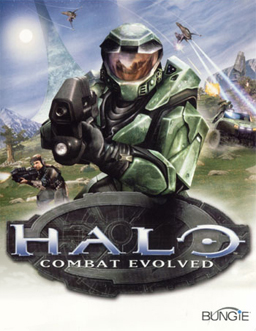Halo. The game that made the Xbox what it was, and kept the system from dying in its infancy. The game that reinvented the concept of the console-based first-person shooter, and gave the few Xbox fans of late 2001/early 2002 a rallying point.
It's fun.
I'm not going to set up the Halo universe for you here; if you don't already know what it's about and you want to find out, go read it elsewhere. This is just about the game.
Halo: Combat Evolved is just simple fun. That's it. It's not overly gritty (though it has its moments), and it's not highly realistic. It's just a very fun sci-fi shooter with a great co-op feature and an awesome multiplayer component.
Bungie's greatest strength isn't necessarily in their ability to alter genres or create entirely new ones, but rather to refine what's already there into a distinct, polished, simple experience. The nearest comparison I can make is with Nintendo and their level of refinement.
The story of Halo is good, though many basic (major) elements of the Halo universe are missing. There's no in-game explanation of what exactly is going on, why humanity is fighting an alien race known as "the Covenant," or who exactly this "Master Chief" is. That might work to the game's advantage, since there's no exposition to get in the way, but it definitely does make the player feel a little bit "out of the loop."
Of course, once the opening mission is completed and the story moves down to the surface of the Halo ring, the player is—figuratively and literally—"in the loop." The player is privy to all the details of the on-ring storyline, and there's nothing you need to know that you don't.
One thing that is a bit of a problem, however, is the way that the game sometimes doesn't do much to guide the player through the world. Many of the environments in the game are vast and repetitious, often lacking clear markers for the player. If you get turned around in a few areas, you might just have to figure out where to go through trial-and-error. Another rather odd feature of the level design is that the path for the player might be not-easily-spotted.
Imagine you're in a hallway. There are fifty doors in this hallway, but only one of them is unlocked. In order to find the correct door, you need to get a good look at each door an find the one with a small green light near the handle.
Similar situations happen repeatedly throughout Halo. You'll be in a large room with tiny alcoves hidden behind catwalks, pillars, glass, and short walls. You need to search through all of that to find a single small doorway. And that doorway will be somewhere, not directly ahead, but slightly off to the side, where you might expect to find a broom closet.
Later games in the series solve this issue, but it's still somewhat frustrating here.
The weaponry in the game is another hit-or-miss (heheh) design feature. The primary weapon, the MA5B Assault Rifle, is so wildly inaccurate that it's only useful at short distances. It's really really useful at short distances, but that's it. In fact, almost all the weapons in Halo tend to favor the "fire in the general direction of your enemy" approach rather than the "be accurate" approach. Even the enemies themselves don't always respond correctly to direct weapons fire, due to inaccurate hit zones. If you shoot an enemy in the arm, you might hit their arm, or you might not. The best thing to do is just aim for their chest and hope for the best, unless you have a sniper rifle and a clear shot at their head. I wonder if perhaps this was done in order to better fit the lessened accuracy of the Xbox controller's analog stick? This actually ends up hurting the later-released PC and Mac ports of the game, as they have a greater degree of accuracy with the mouse, but a slightly frustrating lack of accuracy within the game itself.
Still, however, the game's campaign is plenty of fun in the end, even if it is frustratingly (as said before) simple.
The co-op feature is great. The idea that one player can literally just jump into the driver's seat of a
It doesn't really make sense story-wise for there to be two Master Chiefs—and only one is shown in the cutscenes—but that's not really the important factor.
Bungie made Halo into a phenomenon, if only because it forced people to meet up with each other and play in groups. Two friends could play the story mode together, and four could play the competitive multiplayer. Up to SIXTEEN players could play the game together if four Xboxes and four TVs were linked up with network cables. The simplicity and well-designed structure of Halo made it a great game for almost any gamer, and the multiplayer inspired groups of friends to join up with each other and share in the experience.
All in all, Halo: Combat Evolved is a really great game, even ten years after its initial release. Every gamer with even a passing interest in shooters needs to give it a play-through.
And after that, you should read all the novels. And play the other games.
10/10


